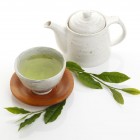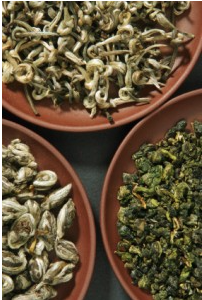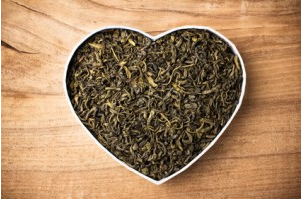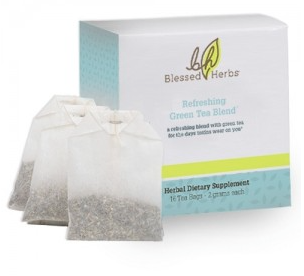
Green Tea – A Hidden Treasure
Green Tea starts out as the same plant as Black Tea – Camellia sinensis. But it’s one of the healthiest draughts you can drink … so what makes Green Tea so much more than its other fresh-brewed brethren? The answer is antioxidants – and a truly unique preparation process!
Green Tea Envy
 All the “official” teas come from the same plant, Camellia sinensis. First brewed in China as a medicine, tea has spread throughout the world as both a refreshing beverage as well as for its health benefits. Green Tea is popular across the globe, and is a drink taken particularly seriously in Japan and as well as its native China.
All the “official” teas come from the same plant, Camellia sinensis. First brewed in China as a medicine, tea has spread throughout the world as both a refreshing beverage as well as for its health benefits. Green Tea is popular across the globe, and is a drink taken particularly seriously in Japan and as well as its native China.
With the only possible exception of White Tea, Green Tea is probably the very best tea for you.
This is because of the unique preparation process used to produce “green” tea – either modern or artisanal methods of Green Tea making leave the maximum amount of polyphenols and antioxidants intact.
Green Tea plants are grown either in the sun or shade, depending on the type of Green Tea being produced. The shoots (tea leaves) or “flushes” are usually harvested three times a year, with the first harvest purportedly producing the very best and most coveted leaves.
Green Tea Production
There are too many different ways to produce the wide varieties of Green Tea to discuss them all. In a nutshell (or teabag, if you’ll pardon the pun) Green Tea is made from fresh tea leaves that are unfermented – which is to say, the natural post-picking oxidation process is halted as soon as the leaves are off the plant.
 Fun Fact: Darker teas such as “black” and Oolong Tea are known as “fermented” tea – which is actually not accurate. These teas have gone through varying levels of oxidation, depending on the type of tea – no “fermentation” is actually taking place in tea production.
Fun Fact: Darker teas such as “black” and Oolong Tea are known as “fermented” tea – which is actually not accurate. These teas have gone through varying levels of oxidation, depending on the type of tea – no “fermentation” is actually taking place in tea production.
Traditionally, this is done by spreading the freshly picked leaves over trays and allowing them to dry in the sun (or another form of gentle, moderate heat) for a few hours. This, combined with a quick heating process stops the oxidation process in its tracks and preserves the leaves’ freshness.
The leaves are then gently rolled or tossed, bruising the edges and releasing the Camellia sinensis plant’s natural oils and active plant compounds, but leaving the center of the leaf green and intact. Depending on the type and country of origin, Green Tea is then either twisted, curled or balled or chopped for packaging, distribution, and brewing.
Caffeine – Green Tea’s most famous ingredient
Green Tea (like all teas derived from the Camellia sinensis plant) contains a modest dose of caffeine. This means that along with the myriad health benefits of Green Tea, you’ll get a much-needed boost whether you’re drinking warm or cold Green Tea any time of day. But that’s not even close to the only reason to enjoy Green Tea – odds are, every part of your body will thank you, from you brain to your heart, to even your waistline!
Green Tea Benefits – Catechin
Earlier, we mentioned the polyphenols and antioxidants abundant in Green Tea. Green Tea also contains a variety of different (and potentially beneficial) enzymes, amino acids, lipids, sterols, carotenoids, vitamins and other minerals.
Because the oxidation process was halted so early in the production cycle of Green Tea, this particular form of tea (along with White Tea) is delivers the most highly-concentrated antioxidant potential; specifically catechin … a powerful antioxidant compound.
Cardiovascular Benefits of Green Tea
Next to water, Green Tea may be the most heart healthy beverage on the planet. And unlike water, Green Tea contains a compound called Epigallocatechin-3-Gallate (EGCG). This and other powerful antioxidants bolster your body’s natural defense against free radicals, which build up during natural cellular activity and contribute to tissue damage and degradation over time.
 However, Green Tea does support your body against a plethora of other negative factors common to western health. Some studies have shown Green Tea to lower LDL lipoprotein (that’s the bad kind of cholesterol).
However, Green Tea does support your body against a plethora of other negative factors common to western health. Some studies have shown Green Tea to lower LDL lipoprotein (that’s the bad kind of cholesterol).
Green Tea may also reduce the severity of coronary heart disease due to several factors: It has been proposed that since many antioxidants found in Green Tea can function as vasodilators, improving the elasticity and flexibility of arteries. How much this affects one’s overall health is entirely dependent on other factors like healthy diet and exercise.
One of the biggest problems with quantifying the health benefits of Green Tea: the populations that drink the most of it also have the lowest rates of cancer and cardiovascular disease. This cannot and should not be solely attributed to Tea – the lack of western lifestyle choices such as processed and hormone-treated food skews the results of these studies.
Green Tea and Weight Management
In Japan, a limited study focusing on the effects of Green Tea and weight loss was conducted. Out of roughly 240 men and women who were given varying amounts of Green Tea for three months, those who received the highest dosage of Green Tea lost the most fat and weight.
Incidentally, those subjects also had lower blood pressure and lower LDL cholesterol than the control groups. Researchers speculate that this is because of the caffeine as well as polyphenol compounds found in Green Tea – compounds known to help with fat oxidation (read: fat usage as fuel).
Drinking Green Tea
 There is a multitude of ways to brew and prepare Green Tea – almost as many as there are varieties of Green Tea itself. Choose the one you like best! There are a few caveats that you should be aware of, however.
There is a multitude of ways to brew and prepare Green Tea – almost as many as there are varieties of Green Tea itself. Choose the one you like best! There are a few caveats that you should be aware of, however.
The first is that (somewhat unsurprisingly) fresh-brewed Green Tea is best. Whenever it comes to botanical nutrients, “fresher is better”. Also, Green Tea extracts, while sometimes effective, are harder on your liver than the traditional brewed Green Tea.
Because Green Tea has such a mild dosage of caffeine, it is both safe and even advisable (if you’re looking for the maximum health benefits and not just a pick-me-up) to treat yourself to several cups throughout the day. Green Tea can interfere with your body’s natural uptake of dietary iron – so, for best results drink Green Tea between meals.
And the best reason to drink Green Tea?
It’s delicious!!










I have a question re: green tea and other herbal teas. I had a
colonoscopy done today. The only concern was the inner lining of
my bowels — should be a nice healthy pink. Mine showed a paleness,
so was asked if I drank herbal teas. My answer “yes” to which I was
told to discontinue herbal teas. Otherwise I was considered very
healthy — on no Rx or over the counter meds. Are you able to give
me any insight and knowledge. This was a conventional medicine
doctor.
Thank you
Ruth
Ruth, I have never heard this. I can find no information on this either.
Thanks Cherie,
I spoke with the doctor today and asked for clarification about the
the herbal teas. She advised that only before a colonoscopy (about
2 weeks before) I should not drink herbal teas as they stained the
lining of the bowel. If so, how often would you advise a bowel
cleanse? I did one in Dec 2015. Thank you.
What is the correct way to brew green tea? Boiling water or near boiling? How long should it steep? Thank you.
I boil water and pour over the tea or tea bag and let it steep 2-3 min.